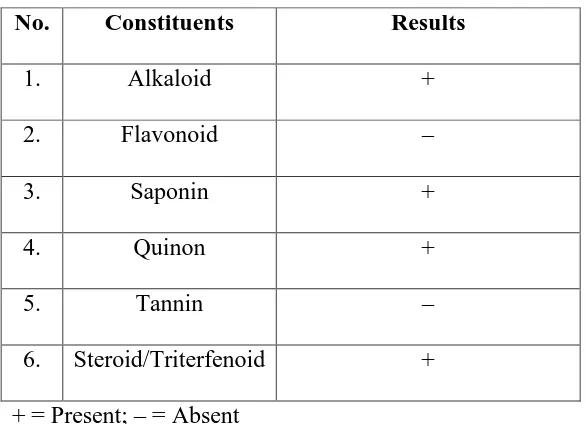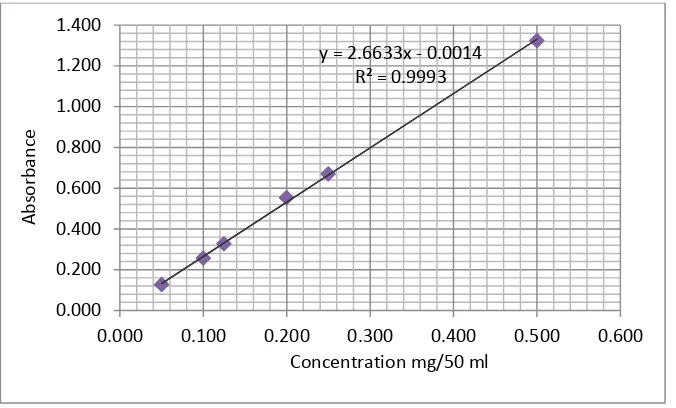1
Comparison of curcumin level in fresh and decoction of dried Curcuma xanthorrhiza Roxb. rhizome
Ramdan Panigoro, Samsudin Surialaga, Diah Dhianawaty D.
Biochemistry Department Faculty of Medicine of Universitas Padjadjaran, Bandung, Indonesia
ABSTRACT
Curcuma xanthorhiza Roxb, is an original medicinal plant from Indonesia. Almost of Indonesian Jamu consist of it, and the people made it in the various methods such as decoction, home made jamu. Nowadays, it is used in the formal therapy, such as in vitamins. It contains curcuminoid which one is curcumin that has various activities. The objective of the research is to evaluate the curcumin concentrations in two different preparation methods, fresh and decoction of dried rhizome. The rhizome was screened of the phytochemical constituents. Fresh rhizome was scraped and was kneaded with 50 ml of boiled water, dried rhizome was boiled in 50 ml water at 900C in 30 minutes, volume to be kept at constant. Both were filtered and the supernatants were evaporated on the water bath. Curcumin were isolated with 50 ml methanol. Concentrations of curcumin were measured with spectrophotometer at wavelength 418 nm. Phytochemicals screening showed of positive results for the presence of alkaloid, saponin, quinon, and steroid/triterfenoid. From 20 g fresh of Curcuma xanthorhiza rhizome and 5.87 g decoction of dried Curcuma xanthorhiza rhizome could be isolated 37.9 mg and 12.95 mg curcumin respectively. In conclusion curcumin concentration that could be isolated from fresh Curcuma xanthorhiza rhizome is higher than decoction of dried Curcuma xanthorhiza rhizome, those are 37.9 mg and 12.95 mg curcumin respectively.
2 Corresponding author
Email : [email protected] Contact: +62818210259
INTRODUCTION
Almost of Indonesian Jamu consist of Curcuma xanthorhiza Roxb. (commonly known as temulawak in Indonesia), is an original medicinal plant from Indonesia. Traditionally it used for fever, chronic cholecystitis, hypercholesterolemia, anorexia, acne, cholelithiasis (gallstones), cholagogue (promotes bile secretion), healthy promoters as well as to increase the production of breast-milk (Hutapea et al., 2001, Dalimartha, 2008). Nowadays, Curcuma xanthorhiza Roxb are used in the formal therapy, e.g. in vitamins as appetite stimulant which
have been named as Curvit, Curcuma Plus, Vitacur; for digestion upset have been named as Curliv; as acolereticum, colagogum and liver protector called as Curcil, Gramuno, Heparviton, Hepasil, Hepatoflak Planta, Hepa Q, and other names (IPA, 2013, Medica Asia, 2010).
3
and aqueous extracts were 101.66 ± 0.8 and , 10.58 ± 0.83 respectively. The total saponin and total alkaloid contents present in the rhizomes of C. xanthorrhiza were 80.90 mg/g and 14.06 mg/g, respectively (Halim et al., 2012).
C. xanthorrhiza had cytotoxic activities, LC50 values for BSLT was 210.3 μg/ml (Nurcholis et al., 2012). Xanthorrhizol is a natural sesquiterpenoid compound isolated from the rhizome of Curcuma xanthorrhiza Roxb. (Zingiberaceae) was suggested has antiproliferative effects on MCF-7 cells (the human breast cancer cell line) by inducing apoptosis through the modulation of bcl-2, p53 and PARP-1 protein levels (Cheah et al., 2006).
The ethanol 70% extract of Curcuma xanthorrhiza Roxb contained xanthorrhizol (m/z 218), in a concentration of 1.0-5.0% (w/v) inhibited the growth of Gram positive bacteria S. aureus and S. mutans, while B. cereus in a concentration of 2.0-5.0% (w/v). The Minimum Inhibitory Concentration (MIC) of ethanol 70% extract toward S. aureus and S. mutans were 0.1% (w/v), while against B. cereus it showed 2.0% (w/v). Phytochemistry analysis showed it consists of alkaloid, quinone, and terpenoids (Mangunwardoyo etal., 2012). Xanthorrhizol, isolated from the methanol extract of Curcuma xanthorrhiza Roxb., has the potent anticandidal activity, the tests showed susceptibility to xanthorrhizol in the MIC range 1.0– 15.0 mg/L for Candida albicans, 1.0–10 mg/L for Candida glabrata, 2.0–8.0 mg/L for Candida guilliermondii, 2.5–7.5 mg/L for Candida krusei, 2.5–25 mg/L for Candida parapsilosis and 2.0–8.0 mg/L for Candida tropicalis. Time–kill curves demonstrated that xanthorrhizol was able to kill the Candida strains with MFCs of 20 mg/mL, 15 mg/mL, 12.5 mg/mL, 10 mg/L, 30 mg/mL and 10 mg/L for C. albicans, C. glabrata, C. guilliermondii, C. krusei, C. parapsilosis and C. tropicalis, respectively (Rukayadi et al., 2006).
4
Oral curcumin at 400 mg/rats (2 g/KgBW) single dose once a week significantly reduces atrophy of soleus muscle in rats immobilized for 2 weeks (Soebadi et al., 2008).
Curcumin is more effective in decreasing total cholesterol level, LDL-cholesterol, number of F2-isoprostan and the formation of foam cell at a dose of 400 mg/kg bw daily (Fikriah et al., 2007).
The research to human body, the antioxidant activity of the curcuminoids of Curcuma domestica L. and C. xanthorrhiza Roxb., and eight compounds which are prevalent constituents of their rhizome oils was examined using thiobarbituric acid reactive substances (TBARSs) assay with human low-density lipoprotein LDL as the oxidation substrate. IC50 value (μg/mL) of the methanol extracts and curcuminoids of Curcuma domestica and C. xanthorrhiza on human LDL peroxidation were 0.31 ± 0.01 and 0.78 ± 0.03 μg/mL respectively. IC50 value (μg/mL) of the essential oils of Curcuma domestica and C. xanthorrhiza and the essential oil standards on human LDL peroxidation were 7.8 ± 0.2 and
5 METHOD
Material
Curcuma xanthorrhiza Roxb., it was identified at School of Life Sciences and Technology of
Institute Technology of Bandung, cultivated at Wonogiri (Central Java), was harvested in October, 2012. Its rhizome has length 13–17 cm; diameter 7–11 cm; fresh (wet) weight = 2,907.4 g; dried weight = 303.02 g.
Curcumin for synthesis: 8203540010 (E.Merck)
Equipment: Spectrophotometer Jenway 6305 UV-Vis single beam (United Kingdom).
Experimental Details
Phytochemical screening of dried of Curcuma longa L. and Curcuma xanthorrhiza Roxb.
Both of rhizomes analyzed for the presence of phytochemical constituents such as flavonoid, alkaloid, saponin, quinon, tannin, and steroid/terpenoid using standard procedure (Harbone, 1973).
Standard curve
The absorbance of curcumin for synthesis in methanol at concentrations: 0.500; 0.250; 0.200; 0.125; 0.100; 0.050 mg/50ml were measured at wavelength 418 nm, and were used to make standard curve.
Dosage in traditional medicine (Dalimartha, 2008).
Fresh C. xanthorrhiza rhizome was used at dosage: 20 – 23 g /day.
6
10 g of fresh rhizome was scraped and was kneaded with 50 ml of boiled water. Then was pressed and was filtered, supernatant was evaporated on the water bath. After dried, curcumin was isolated with 50 ml methanol.
Preparation of the decoction: 5.87 g of dried rhizome was boiled in 50 ml water at 900C during 30 minutes, volume to be kept at constant, then was filtered and supernatant was evaporated on the water bath. After dried, curcumin was isolated with 50 ml methanol. The calculation of curcumin sample concentrations
1 ml of curcumin from fresh and dried solutions were taken and were diluted until 50 ml solutions. Curcumin concentrations were measured at wavelength 418 nm by Spectrophoto-meter Jenway 6305 UV-Vis single beam, and then the results were calculated by linier regression from standard curve.
RESULT AND DISCUSSION
The result of phytochemical screening Curcuma xanthorrhiza Roxb. rhizome contains alkaloid, saponin, quinon, and steroid/triterfenoid.
Table 1: Phytochemical constituents of Curcuma xanthorrhiza Roxb.
No. Constituents Results
1. Alkaloid +
2. Flavonoid –
3. Saponin +
4. Quinon +
5. Tannin –
7
Standard curve of the curcumin concentration were: 0.500; 0.250; 0.200; 0.125; 0.100; 0.050 mg in 50ml ethanol gave the absorbance: 1.323; 0.669; 0.552; 0.327; 0.256; 0.127, respectively.
Figure 1: Standard curve of curcumin at wavelength 418 nm The linier regression is y = 2.663 x – 0.001
Note : y is absorbance and X is sample concentration
Table 2: Curcumin concentration from fresh and decoction of dried C. xanthorrhiza rhizome were measured at wavelength 418 nm
No. samples
Absorbance of C. xanthorrhiza
Fresh Dried
1 0,999 0,690
2 0,995 0,693
3 0,995 0,690
Average 0,996 0,691
Concentration of curcumin 18,95 mg 12.95 mg
y = 2.6633x - 0.0014 R² = 0.9993
0.000 0.200 0.400 0.600 0.800 1.000 1.200 1.400
0.000 0.100 0.200 0.300 0.400 0.500 0.600
A
b
so
rb
an
ce
8
Concentration of curcumin in 20 g fresh rhizome = 2 x 18.95 = 37.9 g
Concentration of curcumin was calculated with the linier regression, y = 2.663 x – 0.001 From 20 g fresh C.xanthorrhiza rhizome and 5.87 g decoction of dried C.xanthorrhiza rhizome could be isolated 37.9 mg and 12.95 mg curcumin respectively.
CONCLUSION
In 20 g fresh C.xanthorrhiza rhizome and 5.87 g decoction of dried C.xanthorrhiza rhizome contained 37.9 mg and 12.95 mg curcumin respectively. Curcumin concentration from fresh Curcuma xanthorhiza rhizome is higher than decoction of dried Curcuma xanthorhiza rhizome, those are 37.9 mg and 12.95 mg curcumin respectively.
ACKNOWLEDGEMENTS
The authors would like to thank to the Authorities of Chemistry Department of Faculty of Mathematics and Natural Sciences of Universitas Padjadjaran for supporting this research project.
REFERENCES
Akazawa N, Choi Y, Miyaki A, Tanabe Y, Sugawara J, Ajisaka R, Maeda S.
‘Curcumin ingestion and exercise training improve vascular endothelial function in
postmenopausal women’, J. Nutres, vol. 32, no. 10, October, 2012 pp. 795-9.
Cheah YH, Azimahtol HL, Abdullah NR. ‘Xanthorrhizol exhibits antiproliferative activity on MCF-7 breast cancer cells via apoptosis induction’, Anticancer Research, vol. 26, no. 6B, December, 2006 pp. 4527-4534.
9
Dhianawaty DD, Andreanus AS, Surialaga S, Martiana AS, Ruslin. ‘Effect of Curcuma xanthorrhiza Roxb. decoct on glucose absorption level in intestine of male rat of Wistar
strain’, Bogor Agricultural University The 2nd International Symposium on Temulawak
and The 40th Meeting of National Working Group on Indonesian Medicinal Plant, Bogor, 2011 pp. 121-123.
Fikriah I. ‘Effect of curcumin on the levels of total cholesterol, LDL cholesterol, the amount of F2-isoprostan and foam cell in aortic wall of rats with atherogenic diet’, Folia Medica Indonesiana, vol. 43, no. 3, July-September, 2007 pp. 136-140.
Halim MRAB, Zabri TMSM, Ismail S, Mahmud R. ‘Standardization and phytochemical
studies of Curcuma xanthorrhiza Roxb’, Int J. Pharm Pharm Sci., vol. 4, no. 3, September, 2012 pp. 606-610.
Harborne JB. Phytochemical methods: A guide to Modern Technique of Plant Analysis. London: Chapman and Hall Ltd., 1973.
Hutapea JR, Djumidi, Sutjipto, Indonesia medicinal plants inventory: Curcuma xanthorrhiza Roxb. 1st edition, Jakarta: Ministry of Health Republic of Indonesia, 2001.
Indonesian pharmacist association (IPA), Indonesia drug specialist information: drug for gastrointenstinal trac, vol.47, Jakarta, 2013.
Jantan I, Saputri FC, Qaisar MN, Buang F. ‘Correlation between chemical composition of Curcuma domestica and Curcuma xanthorrhiza and their antioxidant effect on human low-density lipoprotein oxidation’, Evidence-Based Complementary and Alternative
Medicine, vol. 2012, October, 2012 pp. 1-10.
Mangunwardoyo W, Deasywaty, Usia T. ‘Antimicrobial and identification of active
compound Curcuma xanthorrhiza Roxb.’, Int J. Basic Appl Sci., vol. 12, no. 01, February,
2012 pp. 69-78.
10
Nurcholis W, Ambarsari L, Sari NLPEK, Darusman LK . ‘Curcuminoid contents, antioxidant and anti-Inflammatory activities of Curcuma xanthorrhiza RoxB. and Curcuma domestica Val. promising lines from Sukabumi of Indonesia’, Unesa – Seminar Proceedings , Chemistry National Proceeding, Surabaya, 2012 pp. C284 – C 292.
Nurcholis W, Priosoeryanto BP, Purwakusumah ED, Katayama T, Suzuki T. ‘Antioxidant,
cytotoxic activities and total phenolic content of four Indonesian medicinal plants’, Valensi, vol. 2, no. 4, Mei, 2012 pp. 501-510.
Panigoro R, Dhianawaty DD. ‘Curcumin concentration in fresh and decoction of dried Curcuma longa L. (Turmeric) rhizome as homemade jamu’, Int J Res Phytochem Pharmacol, vol. 3, no. 1, April, 2013 pp. 5-8.
Rasyid A, Rahman AAR, Jaalam K, Lelo A, ‘Effect of different curcumin dosages on human gall bladder’, Asia Pacific J Clin Nutr, vol. 11, no. 4, December, 2002 pp. 314-318.
Rukayadi Y, Yong D, Hwang JK. ‘In vitro anticandidal activity of xanthorrhizol isolated
from Curcuma xanthorrhiza Roxb’, J Antimicrob Chemo., 57, April, 2006 pp.1231-1234 . Soebadi RDH, Pawana IPA. ‘Effect of oral curcumin and immobilization on the diameter of skeletal muscle fiber in Rattus Norvegicus’, Folia Medica Indonesiana, vol. 44, no. 1, Januari-Maret, 2008 pp. 30-34.

